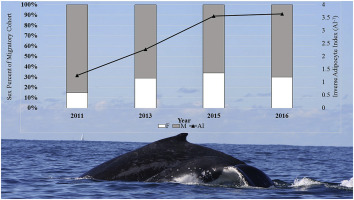Marine Environmental Research ( IF 3.0 ) Pub Date : 2019-06-19 , DOI: 10.1016/j.marenvres.2019.104749 Alison Druskat , Ruma Ghosh , Juliana Castrillon , Susan M. Bengtson Nash

|
Southern hemisphere humpback whales have evolved energetically demanding capital breeding and migratory life-history behaviours. It has been hypothesised that not all individuals of a population participate in the seasonal migration each year, or only undertake partial migrations. Given the cost of migration and reproduction, we explored the possibility that specifically, not all mature females participate in the seasonal migration every year, or significantly delay or shorten their migration, in response to poor feeding conditions. That is, females must attain a minimum threshold of accumulated energy reserves to commit to a reproductive event that likely occurs as a product of mating during migration. With a 1:1 male to female birth ratio, yet a male bias observed along the main migratory corridor; this study utilised inter-annual migratory cohort sex ratios to explore their potential to serve as measures of population fecundity, as a function of ecosystem health. The sex ratios of randomly biopsied adult humpback whales, sampled at a defined location and set time-points along the main migratory corridor from 2008 to 2016 were investigated. Northward migration sex ratios in 2009, 2014 and 2016 revealed a lower male bias suggesting good female participation in the migration and therefore apparent optimal provisioning during the two preceding summers. By contrast, the 2011 southward migration, revealed the highest male bias recorded of 5.75:1. Southward migration sex ratios were found to oscillate closely with measures of population adiposity, a sentinel parameter employed for long-term surveillance of the Antarctic sea-ice ecosystems under the Southern Ocean Observing System-endorsed Humpback Whale Sentinel Program. Anomalously poor humpback whale body condition recorded in 2011 was attributed to poor Antarctic feeding conditions during the extreme La Niña event of 2010/11. These findings lend support for the application of migratory cohort sex ratios, standardised by time and location, as a measure of relative inter-annual population fecundity. This work therefore contributes a new non-lethal tool for the study of population health, as a function of ecosystem productivity, and facilitates the inclusion of fecundity as a sentinel parameter into long-term Antarctic ecosystem surveillance under the Humpback Whale Sentinel Program.
中文翻译:

迁徙的南半球座头鲸的性别比:生态系统健康的新定点参数
南半球座头鲸已经进化,需要繁育资本和迁徙生活史的行为。有人假设并非人口的所有个人每年都参加季节性移徙,或仅进行部分移徙。考虑到迁徙和繁殖的成本,我们探讨了是否存在这样的可能性,即并非所有成熟的雌性每年都会因季节性恶劣的饲喂条件而参加季节性迁徙,或者显着延迟或缩短其迁徙。也就是说,雌性必须达到最低的累积能量储备阈值,以从事可能在迁移过程中由于交配而发生的生殖事件。男女出生比例为1:1,但在主要迁徙走廊上仍观察到男性偏见;这项研究利用年际迁徙队列性别比来探索其潜力,作为生态系统健康的一项功能,作为衡量人口繁殖力的指标。调查了从2008年至2016年在特定迁徙地点和沿主要迁徙走廊设置的时间点进行抽样的活体成年座头鲸的性别比。2009年,2014年和2016年向北的迁徙性别比表明,男性偏见较低,表明女性良好地参与了迁徙,因此在前两个夏季显然有最佳的配置。相比之下,2011年向南的迁徙显示,男性偏见最高,为5.75:1。发现向南迁移的性别比与人口肥胖率的测量值密切相关,在南方海洋观测系统认可的座头鲸前哨计划下,用于长期监测南极海冰生态系统的定点参数。2011年记录的座头鲸身体状况异常差是由于2010/11年极端拉尼娜事件期间南极摄食条件差。这些发现为以时间和地点标准化的移民队列性别比的应用提供了支持,以作为相对年际人口繁殖力的量度。因此,这项工作为研究作为生态系统生产力函数的人口健康提供了一种新的非致命性工具,并促进在座头鲸前哨计划下将繁殖力作为前哨参数纳入南极生态系统的长期监测。















































 京公网安备 11010802027423号
京公网安备 11010802027423号